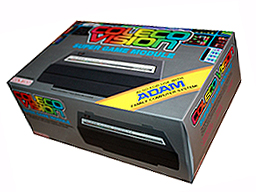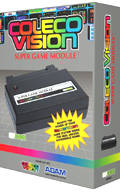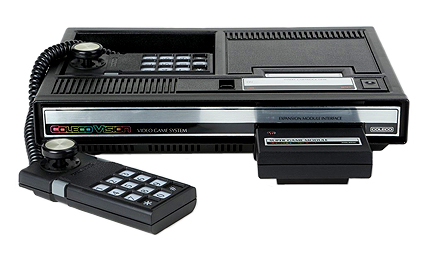This page is not updated for 2023 yet.

© 2013 - 2020 by: Opcode
Games.
Technical advice by: André Lamothe at Nurve Networks.
Do you need new ColecoVision games with more RAM and avanced
sound. ?
In this case, will this ColecoVision Super Game Module 1 be hard to come
by. :)
This device was to mark ColecoVision's 30 years
anniversary back in 2012.
The Super Game Module from Opcode Games, is a
newer hardware for use with our ColecoVision video game console.
There are now 3 SGM1 versions of this little wonder.
The hardware in SGM1 version 1 is basically produced under public license from River West Brands in Chicago, and therefore an official
Coleco product under applicable law.
But it is a Opcode Games product, and therefore is SGM1 version 2 more basically Eduardo's
product.
The hardware from Opcode Games in
SGM1 version 1 and 2 is an RAM expander with built
in MSX AY sound.
The MSX AY sound chip is far more advanced than the regular PSG found inside the
ColecoVision.
So it is a significant upgrade in terms of sound and opportunities.
A little story:
200 Super Game Modules 1 from the first and second round was quickly sold out.
The first Coleco version from Opcode Games,
2012 to 2016 was compatible with
the U.S. NTSC, EU and Australian PAL and ADAM Computer Systems.
In December 2016, an updated version of SGM1 was launched, and this module
became compatible with the French CBS Scart ColecoVision.
The Super Game Module allows you to run the
so-called ColecoVision Super Games.
You can recognize a Super Game on these brands below:



These labels is to find on the package, as well
as on the
cartridge.
Some ColecoVision games will also have the SGM expanded color support.
Some Super Games from Opcode Games
have a production number which always starts with SG for Super Game.
The Budget Color Line series with RC 24XX.
And in a combination together with the new
SGM, is a new Cartridge PCB for all new and upcoming Premium SGM games produced
from November 2016.
This new PCB are named ColecoVision Super Game
Cartridge or just (SGC).
SGC will not be used for the Budget Color Series which for now is 19 ColecoVision games, they use instead the MegaCart 1
PCB.
SGC Premium is powered with a very avanced Bank switching and with Save features be a lot advanced.
The
Save function is based on EEPROM, with data retention of 100 years and
endurance of 1 million write cycles.
With that means you are able to play the game 1 million times on
average before the EEPROM fails.
The new ColecoVision Super Game
Cartridge can also be used with regular ColecoVision games.
The SGC Premium will be backward
compatible for SGM.
First announced Super Games from Opcode Games that get use the new Super Game Cartridge
was Penguin Adventure and Gradius.
And for this to be done, there was made a brand new PCB board for this new
cartridge. (SGC).
The idea for the Super Game Module and the new cartridge PCB
was to make more complexed games for
our ColecoVision.
The Opcode Super Game Module upgrades our current ColecoVision video game console from its standard 1 K RAM, with
up to
extra 32K (24) RAM.
Both SGM1 versions of the Super Game Module has also a
more avanced sound chip inside than the one in our ColecoVision.
This avanced sound chip was one of the most known out there in the 80's, namely the AY-3-8910A.
AY-3-8910A was already a known audio chip, for example in some MSX
computers and earlier arcade machines.
The Super Game Module 1 is just an simple expander
with more RAM and better
sound, there is no graphic chip inside.
The great games is in the Cartridge itself. (all codes incl. graphics).
Eduardo at Opcode Games has already ported several games from
the previous
MSX1 and Sega SG-1000 titles, and some of those are already available for our ColecoVision
for years.
All titles below are converted 80's games.
Released under the Opcode Games label is: Space Invaders Collection, Sky
Jaguar, Yie Ar Kung-Fu I and II, Magical Tree, Road Fighter, Pac-Man Collection,
Gradius and Penguin Adventure.
Non released, but originally planned was: Galaga, Super Hang On,
Hyper Rally, Time Pilot, Lady Bug, Frogger, Popeye, Pengo, DKA, Pac-Man
DX, Space Invaders DX and Track &
Field 2.
Eduardo do also convert games for CollectorVision Games and Team
Pixelboy.
Some with the SGM features, and also many before the SGM came out.
Many new programmers has opened their eyes and
now making their ColecoVision games for the Super Game Module.
They already know they can detect the 24 kb. of RAM, and the AY sound chip
for a nice and different sound than we were used to.
Some programmers are skilled at combining the SN and AY sound chips for
even more varied sound.
For ultimate sound they use the WSG Soundchip in the Phoenix VGS Console.
Programmers don't need to stop at the 32kb. barrier.
Is the game bigger than the 32kb., is Opcode Games ready with both the
MegaCart1, (MC1) and the Super Game Cartridge (SGC).
MegaCart1 supports both ColecoVision and the Super Game Module, but Super
Game Cartridge supports only the Super Game Module and the Phoenix VGS
console, and can not work with
an ordinary ColecoVision.
SGC and SGM is combined to each other.
|
SGM = Super
Game Module
SGC = Super
Game Cartridge
Publishers:
OPG = Opcode
Games
TP = Team
Pixelboy
CVG = CollectorVision
Games
ColecoVision
Super Game Titles:
|
Following Super Games
Released: |
Following Super Games
Planned: |
Following Budget Super Games
Released: |
Following Budget Super Games
Planned: |
|
Zaxxon Super Game SGM
2013
TP
Dragon's Lair SGM
2013
TP
King's Valley SGM
2013 TP by:
OPG
Thexder SGM 2013
TP by: OPG
Rollerball SGM 2013
CVG by: OPG
Buck Rogers Super Game SGM
2014
TP
Galaga SGM
2014 CVG
Goonies SGM
2014 TP
by: OPG
Subroc Super Game SGM
2014 TP
Twinbee SGM
2014 TP by:
OPG
Comic Bakery SGM
2014 TP
Zanac SGM
2015
CVG
by: OPG
Knightmare SGM
2015
TP by: OPG
Spelunker SGM
2015
TP
Stone Of Wisdom SGM
2015 TP
Super Pac-Man SGM
2016
TP
Mappy SGM
2016
TP by: OPG
Rally-X SGM
2016
TP by: OPG
Caos Begins SGM
2016
TP
Majikazo SGM
2016
TP
Knight Lore SGM
2016
TP
Mecha 9 SGM
2016
TP
Operation Wolf SGM
2016
TP
Star Soldier SGM
CVG
2016 by: OPG
Jumpland SGM
2016
CVG
Sasa SGM
2016
CVG
Kung Fu Master SGM
2016
CVG
by:
OPG
Gradius SGM SGC
2016 by:
OPG
Penguin Adventure SGM SGC
2016 OPG
Monster House SGM
2017
CVG
Hole in One SGM
2017
CVG
Sparkie SGM
2017
CVG
Loco Motion SGM
2017
CVG
Juno First SGM
2017
CVG
Ghostbusters SGM
2017
TP by: OPG
Secrets Of Moai SGM
2017
TP by: OPG
King & Balloon SGM
2017
TP OPG
Children Of The Night SGM
2017
TP by: Antoni
Wizard Of Wor SGM
2017
TP by: Lemonize
Zombie Incident
SGM
2017
TP
Arkanoid
SGM 2018
CVG
Gauntlet SGM
2019
TP
1942 SGM
2019
TP
QBIQS SGM
2019
TP
Uridium SGM
2019
TP
Booming Boy SGM
2019
TP
The Cure SGM
2019
TP
Ghost
SGM 2019
TP
Prisoner Of War SGM
2019 TP
Space Shuttle SGM
2019
TP
Donkey Kong 3 SGM
CVG
Arcomage SGM
2019
TP
Bomber King
SGM
2019
TP
|
Dig Dug SGM SGC
by: OPG
Donkey Kong Jr. SGM SGC
by: OPG
Pengo SGM SGC
by: OPG
DKA
SGM OPG
Moon Patrol ?
Pole Position ?
Popeye SGM SGC
by: OPG
Xevious ?
Gyruss ?
Donkey Kong II ?
Lady Bug Arcade SGM SGC
by: OPG
Time Pilot Arcade SGM SGC
by: OPG
Frogger Arcade SGM SGC
by: OPG
Pac-Man DX SGM SGC
by: OPG
Space Invaders SGM SGC
by: OPG |
Warp & Warp SGM
2016 by: OPG
Bosconian SGM
2016 by: OPG
Tank Battalion SGM
2016 by: OPG
Caverns of Titan SGM
2017
TP
Cold Blood SGM
2017
TP
Danger Tower SGM
2017
TP
Deep Dungeon Adventure SGM
2017
TP
Heroes Arena SGM
2017
TP
J.E.T.P.A.C. SGM
2017
TP
Shmup ! SGM
2017
TP
Shouganai SGM
2017
TP
Stray Cat SGM
2017
TP
Traffic Jam SGM
2017
TP
Txupinazo ! SGM
2017
TP
Pacar SGM
2017
TP
Champion Pro Wrestling SGM
2017
TP
Guardic by: SGM
2017 by: OPG
Penguin Wars by: SGM
2017 by: OPG
Alpharoid
SGM
2018 by:
OPG
Yie Ar Kung Fu II SGM
2018 by:
OPG
Sweet Acorn by: OPG
Xyzolog by: OPG
Bull & Mighty by: OPG
Dorodon by: OPG
Mobile Planet Styllus by: OPG
Mouser by: OPG
Bokosuka Wars by: OPG
|
Door Door by: OPG
Choro Q by: OPG
Cabbage Patch Kids by: OPG
Ghost House by: OPG
Godzilla by: OPG
High Way Star by: OPG
|
|
|
Most of the games above have never been released to
our ColecoVision platform before, other is upgraded for better sound and
extra RAM.
All upcoming games from Opcode Games will be launched as expanded games, and will require the Super Game
Module or Phoenix VGS console to work.
All the Premium games from Opcode Games has improved sound and graphics,
plus the
save game features.
Improved graphics means colors like it would have been in a real Arcade
machine.
Improved graphics only applies ColecoVisions or other compatible consoles with
either the F18A Graphic card
installed or via FPGA.
Also planned Super Games is Phoenix Video Game, Kangaroo, Berzerk, but
those games are long term Super Games projects together with DKA.
But of course not all upcoming games will require this Module, few upcoming games from
Team Pixelboy and CollectorVision will not all make use of the Super Game
facilities.
More story:
When ColecoVision was launched in the U.S. in August 1982, was it an early "unfinished" MSX-based
machine.
Just a year after in 1983 came the first SpectraVideo 318
who also was an unfinished MSX machine, but closer to the actual MSX1.
Both SpectraVideo 318 and ColecoVision was "close" in their scructure.
Same CPU, VDP, VRAM, Text Modes and Resolution.
SpectraVideo made a ColecoVision video game adapter for their SVI 318.
SpectraVideo was later owned by Bondwell Holding in Hong Kong, and some
CBS ColecoVisions was also made in Hong Kong.
CBS ColecoVisions is from 1983 just like the SpectraVideo 318.
Sega SG-1000, also from 1983 was also built
up around the Z80, same resolution, same VDP, 1K RAM, 16K VRAM and
even the sound chip was the same as ColecoVision.
So games from ColecoVision and Sega SG-1000 was very similar and easy to
convert.
But also games from MSX1 are close in its structure, same CPU, same VDP, but the first MSX standard changed the sound chip to AY-3-8910.
It was MicroSoft in Japan who starting up this
MSX standard.
MSX stands for: MicroSoft
eXchange,
(an act of giving and receiving from one MSX to another MSX and vice
versa).
So practically all those "finished" MSX games from the
mid 80's can
now be translated back
to ColecoVision with very few changes.
When ColecoVision was at its highest level in 1983, came MSX to the world
as a new standard for MSX Home Computers.
All the MSX1 standards could now "talk together" in some way.
This also applies for the Sega SG-1000.
And here comes the new Super
Game Module into the picture.
We already share the same CPU and Video processor.
ColecoVision og SG-1000 has even the same sound chip, but it is the number
of RAM that's the difference.
And with the AY MSX sound on our Super Game Modules
and converted MSX games
can we get our ColecoVision much closer to the MSX games database.
And with our SGM1 is sound no longer a problem, it is a whole new world.
The AY-3-8910 sound chip is a step forward from ColecoVision
and Sega's own sound chip, namely SN
76489AN.
The AY-3-8910 is the extra audio chip inside of the 2 versions of
the Super Game Module, and it is
also used by lots of other homecomputers and arcades in the 80's.
The Super Game Module can detect both audio chips individually or at same
time.
The Super Game Module must be mounted in the expansions port on the front of
ColecoVision.
For the ADAM Family Computer System is the Expansions port located on the right
side of the Memory Console.
The Module is backward compatible, so
almost all upcoming games and almost all the existing games will work without any problems.
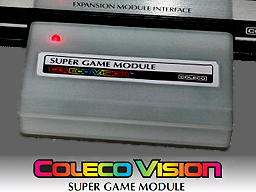
You don't have to unplug the Super Game Module from the expansion
port if you don't play the Super Games.
You can safe let it be there without any problems, except for the
following games: Bomb 'n Blast and GameSter81/Game on Expo.
With these two games will your SGM then have to be disconnected.
You can always play regular ColecoVision games with the Super Game Module plugged in at any
time.
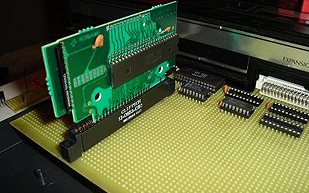 |
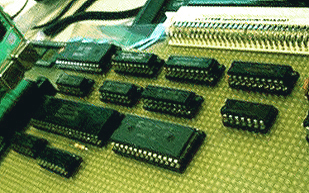 |
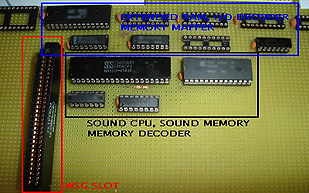 |
|
Here are pictures from Opcode's earlier
work with the expansion module, which is also allowed a graphical
enlargement. |
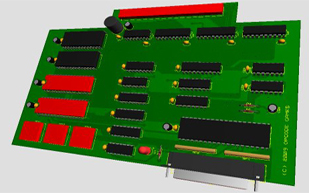 |
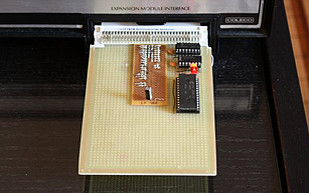 |
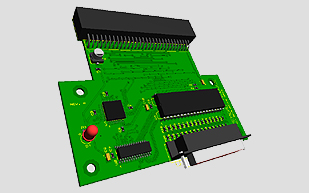 |
Eduardo at Opcode Games joined Andre Lamothe at Nurve Networks at the now
former XGameStation with his new idea, and
they redesigned the unit from the buttom.
Andre gave Eduardo the technical advice so Eduardo could continue his work
with the team in Brazil.
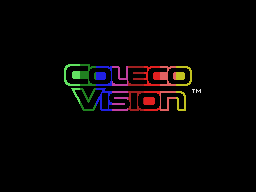
This is the former start-up sequence from the earlier Opcode Games.
It was planned to remove the start-up sequence from the cartridge, and let
it show from the former "Super Expansion Module/SEM".
But it was dropped again and it is now back on the cartridge in a new
format as
you can see below.
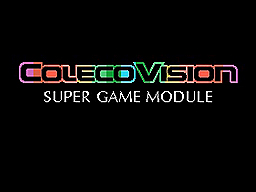
This is the newer SGM start up sequence.
This new sequence will replace the old start-up sequence
shown above with this new animated one.
All new Opcode ColecoVision SGM1 Games will feature this little animation.
Click on the Image to see the newer start-up sequence.
- Programmable AY Sound Generator:
x
The sound in SGM1 and the SGM1 2nd run version of the Super Game Module is provided by the
AY-3-8910 PSG.
The same used with
almost all MSX computers and many other
computers and arcade machines from the '80s.
The main reason is to allow more faithful ports of MSX and the most Z 80
based arcade games.
The people who created the ColecoVision made a bad mistake with the CV PSG. The CV
PSG isn’t bad at all, but they clocked it too high.
Because of that, we are limited to frequencies above 110 Hz, which means,
that deep bass sounds can not be produced by the ColecoVision.
So that is why the Space Invaders Collection marching sound in SIC isn’t
as deep as you remembered it,
or some music stuff sounds so “high” in the frequency range.
The new PSG corrects that, and goes beyond what the Texas ColecoVision PSG can do,
with volume envelope and better noise generator.
The AY helps by offering a wider frequency range and by increasing the
total number of channels available.
Additionally both PSGs can be used simultaneously, and all sound is routed
to the RF output.
(A/V mods can still work if the sound source is taken from the output of
the sound mix, just before the RF input). |
Eduardo decided for around 16 years ago to make the
old Donkey Kong
game in an strong and improved ColecoVision version, than the original 1982 ColecoVision version from Coleco
Inc.
So for the best sound studied Eduardo 6502 assembly, and by consequence he was able to analyze the Famicom / NES
version of Donkey Kong.
With that he have the routines he need to be able to reproduce the few
analog sounds found in the real arcade game.
One set of sounds for the SN chip, and another set for the AY
and a 3rd one for the WSG Soundchip in Phoenix VGS console.
The Dutch musicmagician
Maarten van Strien also called Wolf has unfortunately turned down its
participation in
DKA., he does not have the time to help with the sound this time.
So Eduardo must find another one who will be creating the opening tune for
DKA.
The DKA release is delayed until late in
2021.
There is for now over 1000 people on the waiting list for DKA on SGM.
All new game Cartridges from Opcode Games will be produced and assembled
in China.
With the Super Game Module and a related Super Game, will you have a sound you never have
heard before from your ColecoVision.
What about graphical options.
(For Programmers)
About graphics, the SGM1 doesn't change the internal graphic chip from
ColecoVision, but the extra
RAM can help graphics in many ways.
One can for example create one or more frame buffers for dynamic parallax
scrolling (by dynamic means planes that can be modified on the fly).
Or have a dynamic pattern table in RAM. Or have a lot of movable objects
on screen using tiles.
Those are things you simply cannot do well with a single KB of RAM, and
animating right from the VRAM is too slow for practical purposes.
Another example is smooth scrolling. You can do that in ROM, but then you
are going to need a huge cartridge for all the pattern variations.
With the SGM even a regular 32KB cartridge can offer smooth scrolling in a
game with several different stages.
Not to mention games that are a lot more complex.
How can you create a huge RPG that keeps track of hundreds of items and
enemies scattered all around the game world. ?
With 1 KB you cannot.
So the amount of RAM Coleco included with the ColecoVision simply restrains the
system from its full potential.
So many examples, some of the best chip tune players out there uses self
modifying code and you cannot do that with 1 KB.
For ColecoVisions with the installed F18A Graphic card, have you
automatically more Colors, no Flickering and a perfect scroll in all
directions. |
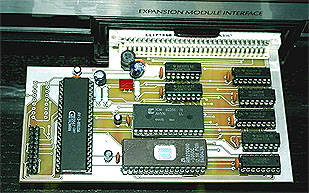 |
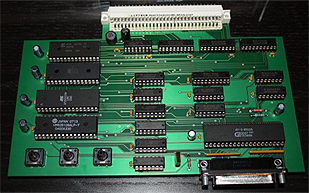 |
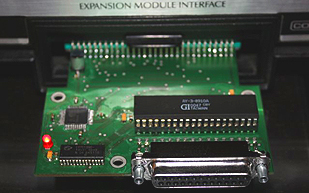 |
|
The 1st. newer prototype PCB. |
The 2nd. newer prototype PCB., very nice work |
The 3rd. newest Prototype out of several.
This one from march 2010.
With the 2 x 8 bit I/O port mounted. |
|
|
Nurve Networks was offering technical
consulting.
The SGM project was in the beginning top secret in details.
Latest version only need 3 chips, and still advanced.
The 3 chips on the SGM are 1 for Sound, 1 for RAM and 1 for the CPLD.
|
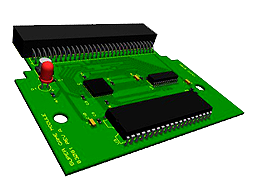 |
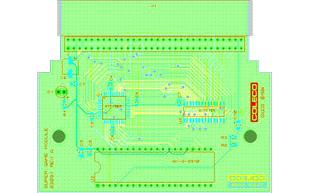 |
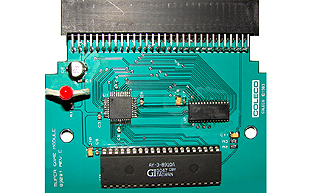 |
|
A 3D Image of Revision A. |
Revision A
The I/O port is removed. |
The REV. E PCB. April 2013.
80% made in China.
This showed version do not support the French RGB. |
The casing around the electronics was tested
with an empty ADAM Auto dialer case, earlier used from the ADAM Family Computer System
from the mid 80's.
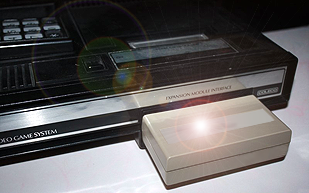 |
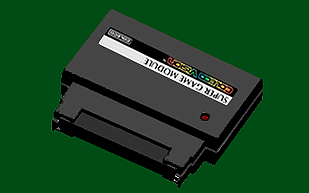 |
|
Left - ADAM Auto Dialer as a case for the SGM.
Right - Photoshop'ed by ColecoVision.dk |
The final case for the SGM is Black
or Smoke Black for matching the ColecoVision design.
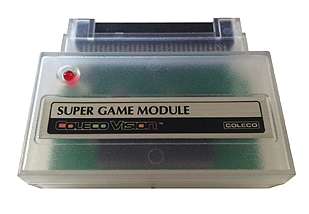
A few clear beta cases was manufactured together with a few milky white for beta-testers.
ColecoVision.dk tested, however, a version in black color.
The SGM size is: Length 4.125" x Width 3.50" x Height 1.750"
Including the support leg underneath.
That will in Centimeters say around: Length 10,5 cm. x Width 9,0 cm. x Height
4,5 cm.

SGM
Box 1, non Scart version, including styrofoam insert is: 9" x 6" x 3.5"
In Centimeters ca.: Length 23 cm. x Width 15 cm. x Height 9 cm.
SGM only: Approximately 1.75 inches high, 3.5 inches deep and 4.3
inches long.

SGM
Box 2, #2403, the Scart version is: 8" x 6" x
1.5"
In Centimeters ca.: Heigth 20 cm. x Width 15 cm. x Deep 6 cm.
SGM only: Approximately 1.75 inches high, 3.5 inches deep and 4.3
inches long.
Included in the 2 versions of the Super Game Module.
?
- Super Game
Module to be plugged in the ColecoVision or ADAM expansions port.
- Up to 32 KB expanded RAM. for more advanced games.
- Spinner IRQ control, (not confirmed).
- New Sound generator AY-3-8910. for more advanced sound.
- Power LED indicator.
- ColecoVision Super Game Module manual + Addendum for credits and
copyrights.
- A small catalog with all upcoming SGM Games from Team Pixelboy and Opcode Games. |
|
And here is some important data for REV E/F.
(for programmers, Coleco Brand and Opcode
Games Brand).
- 32 KB of RAM, disabled by
default.
Can be individually mapped as following: 24KB to address range
2000h-7FFFh,
8KB to address range 0000h-1FFFh (BIOS is disabled).
- PSG AY-3-8910, increasing sound channels to 6 + noise.
Comes with a new
Magnetic lock box.
Works with all
ColecoVisions, NTSC, PAL and the French Scart version. |
But again, the SGM is only the half of the
deal.
The other half is the new Super Game Cartridge, with unprecedented bank
switch flexibility and data retention capabilities.
The Super Game Cartridge PCB is where you store your Super Game in.
The combination of both pieces of hardware fulfills the original SGM
promise:128 KB of media space -actually 1 or 2Mb in Super Games' case.
With the extra advantage of being far more reliable than magnetic tape.
Expanded RAM (32 KB) and data retention for saving high-score tables and
more.
Opcode Games had originally a plan about advertising his Super Game Module through
Facebook, Gaming Magazines, Youtube,
Retro Gaming Websites, Merchandise etc.
But it is only announced via Opcode Games website, Facebook, AtariAge.com
and some Retro events.
And the Internet is fast, very fast, so the news was
anyway
quickly spread all over the world in no time.
And like Eduardo says to ColecoNation for a years ago:
"For us collectors and classic gaming fans alike,
is increasing lifespan for our consoles very important, because we are already witnessing
to
our beloved machines is slowly dying.
That is a concern when creating new devices".
Full support and technical documentation of the Super Game Module and the ColecoVision Super Game Cartridge
is available for everyone who works with ColecoVision programming.
Consult Opcode Games, just note that, they can
sometimes be very busy,
(Travel a lot between USA and Brazil),
and therefore not
always quick to respond
back.
And here are some technical details about the RAM expansion.
(For Programmers)
Some of you programmers are well aware, ColecoVision work RAM is limited
to 1KB, mapped from 6000h to 63FFh, and then mirrored to 6400h until 7FFFh
(so 8 times).
The ColecoVision also includes 8KB of BIOS routines, mapped from 0000h to
1FFFh.
The SGM expands the work RAM from 1KB to 32KB as a maximum.
Here is how:
24KB can be mapped from 2000h to 7FFFh. When mapped, the internal 1 KB of
RAM is no longer accessible. All legacy software still works normally
under this mode.
However, since the SGM must also be compatible with the ADAM, the 24 KB of
extra RAM is NOT enabled by default.
In order to use that expanded memory in a ColecoVision system, the
programmer must first enable it.
But before doing so, you also need to make sure the module isn’t attached
to an ADAM system, otherwise there may be a memory conflict with potential
for damaging the ADAM and/or the SGM.
So the first step is to check if the 24 KB are already available. If they
are, then you have an ADAM system, and the SGM1 expanded memory should NOT
be enabled.
If no memory is found (in the 2000h-5FFF range), then it is a ColecoVision
system and the expanded memory can be enabled.
To do so, set bit0 in I/O port 53h to 1, like this (in assembly): LD
A,00000001b ; OUT(53h),A
You can also map 8 KB of RAM (for a total of 32 KB) to address range
0000h-1FFFh. However, when doing so, the ColecoVision BIOS will be
disabled.
RAM and BIOS can be mapped back and forth, though. To map RAM to the BIOS
area, simply set bit1 in I/O port 7Fh to “0”.
In order to keep full compatibility with ADAM systems, all bits in I/O
port 7Fh must be set to specific values, though. Here is how you should
set the port: if you want the BIOS, set the port to “0001111b”.
If you want RAM instead, set the port to “0001101b” (see example above on
how to do that in Assembly). Make sure you respect those values, or your
game may not work on ADAM systems.
Eduardo has planned to release complete ASM libraries for detecting ADAM, SGM,
and then setting RAM appropriately.
Eduado at Opcode Games recommend using those libraries, so that we can
eliminate the risk of enabling the SGM expanded RAM on ADAM systems.
Here are the steps required to initialize a Super Game Module game:
(Coleco brand.)
1) When initializing your game, use RAM in the 6000h-63FFh range,
because the SGM expanded RAM is disabled by default, and you must make
sure it isn’t an ADAM before enabling it.
2) Run some memory tests to establish if RAM is already present in
the 2000h-5FFFh. If it is, then you have an ADAM system. In that case,
DO NOT enable the expanded RAM. Go to step 4
3) If no memory is found, then we have a ColecoVision system, and
the SGM expanded RAM can be enabled. Do so by setting I/O port 53h to 01h.
You shouldn’t disable expanded RAM after that (i.e., do not access I/O
port 53h again after initializing it).
4) Now that you know that 24 KB of RAM is available, your game can
start using it.
5) Optionally you can replace the BIOS with RAM, using I/O port
7Fh. Make sure you only use the two values described above (‘00001111b’,
‘00001101b’), or your game may not work on an ADAM system.
Eduardo finally note about the SGM and ADAM: AFAIK, I/O port 53h isn’t used
by any known ADAM device, so it should be safe to use the SGM with all
ADAM expansion cards in place.
However Eduardo cannot guarantee that a future (or even current) device
will not use (or may be already using) that specific port.
Users must make sure there is no other device in their ADAM system
using port 53h.
Basically would Eduardo like to see the routine, programmers are using for
the SGM detection, and also make sure that programmers don't touch the memory
control.
Eduardo at Opcode Games will share the detection routines, but programmers will
also need to come up with their own routines.
SGM Module: Expanded AY Sound and Extra RAM.
SGC PCB: Very big and avanced Super games, plus Save game features.
Many talented programmers is already jumped aboard and hopefully soon
we will see games that were created to the SGM from scratch.
Super Games will be
taking full advantage of the extra RAM and Sound.
Games that blow away our condemn of what a ColecoVision game looks and play.
Just remember, ColecoVision is: "The Arcade Quality
Video Game System", and the arcade games from the 80's appeals
to it.
|
Can I
still get a Super Game Module ? |
Opcode Games has sold several hundreds units in record time in a period
from 2013/14 later 2015
and again in 2016/17.
The goal was to ship about 500 modules total but 700 was sold and
was quickly sold out.
Also a 4th run, which
should raise
the sales further, and a total of over 1000 units is completely sold out.
There is now 504 SGM's in the 5th run.
Would you like to order one from the 5th run of the 2020 version, please contact:
Opcode Games.
Shipping expected around November 2020.
With regard to the French CBS SGM version.
The French CBS SGM version is included from the 3rd SGM version from
December 2016 and sold from January 2017.
The new 5th version works with NTSC, PAL and French PAL.
ColecoVision.dk was one of the beta testers
for the first generation in October 2012 and the French 3rd. version in June
2016.
When ordering the SGM1, will the box contain following: The new Super
Game Module just to plug in your Original ColecoVision.
A professionally printed box, with manual and catalog.
The packaging mimics the classic ColecoVision packaging design from
1982/83, so it match your ColecoVision collection nicely.
DKA will probably be sold
around late in 2021, and probably cost around $ 70,- each plus
shipping.
The first SGM was officially licensed from: River West Brands / Coleco Holding LLC.
(Coleco Brand) (1st run) (1st nameplate)
The second SGM. is Opcode Games LLC product. (Opcode Brand) (2nd and 3rd
run) (2nd nameplate)
The 3rd SGM. is Opcode Games LLC product. (Opcode Brand) (4th and 5th run) (3rd nameplate)
Super Game Cartridge SGC belongs to Opcode Games.
Note: The Super Game Module as a psysical
product, is for use with the old and original ColecoVision.
This plug in product will not work together with CollectorVision Phoenix
Video Game System.
CollectorVision Phoenix Video Game System has this feature built in on
their system already from the beginning.
The old toy brand: "Coleco",
belongs now to
Dormitus together with
RWB, all the same company.
They collect brands and sells related licenses.
As opportunities are now, you will have a
combined system consisting of your existing ColecoVision, as well as an
expansion module.
You keep your original classic ColecoVision and with expansions, you will have access to
all new extended ColecoVision Super Games.
ColecoVision.dk has nothing to do with the sale and
production of the Super Game Module, nor even the Super Game Cartridge.
All questions should be directed to:
Opcode Games |
©
The SGM Games and the SGM Module belongs to Opcode Games LLC.
All images and all text in this documentation is published by: Eduardo Mello, Opcode Games and reproduced by ColecoVision.dk
Last 7 updates:
August 03, 2020.
June 15, 2020.
March 09,
2019.
November 25,
2018.
November 21,
2018.
November 20,
2018.
January
10,
2018.
This is 100% until other information is published.
Please report errors or confirmed changes so it can be corrected. |
